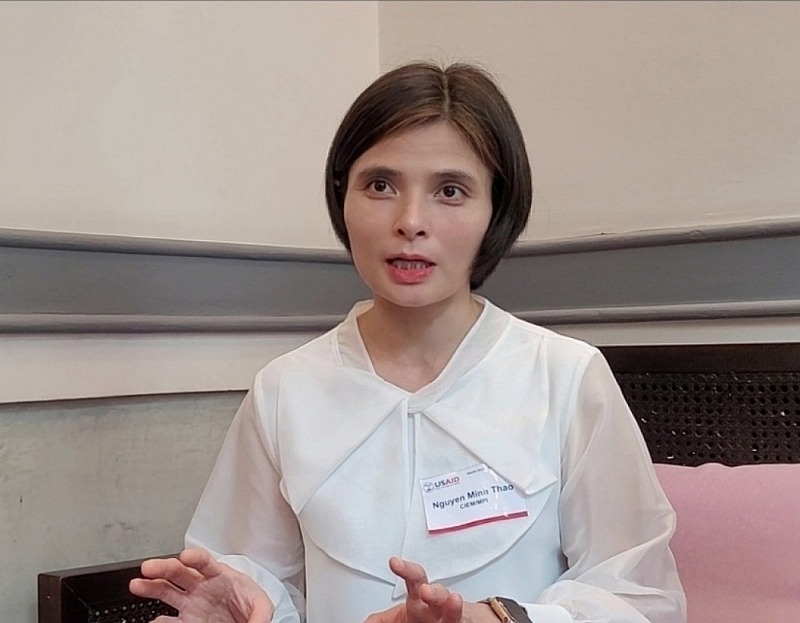VCN – After five years of implementation, the Trade Facilitation Project (TFP) funded by the United States Agency for International Development (USAID) has brought remarkable results. Customs News spoke with Ms. Nguyen Minh Thao, Head of the Business Environment and Competitiveness Research Department at the Central Institute for Economic Management about the role of the Customs administration in this project.
 |
| Ms. Nguyen Minh Thao, Head of the Business Environment and Competitiveness Research Department at the Central Institute for Economic Management |
How do you assess the results achieved after the five-year implementation of the project in creating spillover effects on administrative procedure reform in Vietnam?
The TFP set the goal of creating a breakthrough for specialized inspection activities in general and administrative reform in the field of customs in particular. The higher ambition of the project is to connect and share data with specialized management ministries in carrying out customs clearance procedures which include both customs procedures and specialized inspection procedures of relevant ministries and agencies.
Accordingly, after a five-year implementation, the project has brought a visible effect of applying science and information technology (IT) to the management process. It is not easy to give a specific number to evaluate the results of the project but the clearest result is the outstanding effort in administrative reform of the Customs authority.
In particular, it is most clearly shown that the IT system is strongly applied to simplify customs procedures, create maximum conditions for businesses, as well as apply risk management thoroughly in all stages of operations.
I saw that, in the five-year implementation of the TFP, the highly appreciated results are thanks to the role and efforts of the Customs authority. In addition, reforms in the customs sector are good experiences, and put pressure on ministries and agencies to change the internal management model, including the application of IT and the application of risk management model. The efforts of Customs authority are considered spillover effects as well as great, long-term and sustainable impacts.
In addition to the effectiveness of administrative procedure reform in the field of customs, another result the TFP brings is the connection between the business community and management agencies. TFP has reflected real life to promote the sharing from the business community, actively contributing to the law-making process. It can be said that this is one of the highlights of the TFP. Because through the TFP, the connection between businesses and State agencies is harmonious and rhythmic.
What is the role of the General Department of Customs as well as the effectiveness of the reform work in the field of customs of the TFP?
In the project, the Ministry of Finance is the focal point agency and specifically the General Department of Customs is the lead agency in charge of the implementation of the activities. To create the success of the project, the proactive close coordination of the Ministry of Finance, the General Department of Customs with the project sponsors and stakeholders is extremely important.
The results of the project show the special attention from the leaders of the General Department of Vietnam Customs in the direction and close administration, even creating greater pressure than the initial expectation that the project set.
In my opinion, in any field, the key role for success in reform is the attention and direction from the head of the enforcement agency. For the TFP project, although there are still many problems we have not solved, at least the connection between the parties has been made, in particular, ministries and agencies have shown their attention to issues raised by the Customs authority. This is one of the positive points assessing the role of the Customs authority in this project. I think that the attention and direction of the leaders of the General Department of Vietnam Customs in connecting ministries, agencies and the business community willing to cooperate, participate and contribute to the development of legal policy documents is really significant.
The application of the risk management model in the project implementation process from the Customs authority can be considered valuable experience for other ministries and agencies to learn, ma’am?
In Vietnam, Customs has been considered a pioneer in administrative procedure reform, the first agency to apply the risk management model in operations.
In implementing the TFP, the Customs authority has learned from international experiences and introduced many ideas to institutionalize food safety and quality management to facilitate customs clearance. However, the reform is really a difficult process, requiring continuous efforts and enthusiasm from ministries and agencies.
Although many ministries and agencies have gradually applied the risk management model in food quality and safety management, the ways and levels of application among specialized agencies have not been consistent. Therefore, the pioneer in the application of risk management by the Customs authority when participating in the TFP is expected to be good lessons and experience for other ministries, agencies and industries, especially in specialized management, quality and food safety management.
Thank you!
By Nu Bui/ Huyen Trang
